- Home
- Robert Graves
The Greek Myths, Volume 1 Page 3
The Greek Myths, Volume 1 Read online
Page 3
If some myths are baffling at first sight, this is often because the mythographer has accidentally or deliberately misinterpreted a sacred picture or dramatic rite. I have called such a process ‘iconotropy’, and examples of it can be found in every body of sacred literature which sets the seal upon a radical reform of ancient beliefs. Greek myth teems with iconotropic instances. Hephaestus’s three-legged workshop tables, for example, which ran by themselves to assemblies of the gods, and back again (Iliad xviii. 368 ff.), are not, as Dr Charles Seltman archly suggests in his Twelve Olympian Gods, anticipations of automobiles; but golden Sun-disks with three legs apiece (like the emblem of the Isle of Man), apparently representing the number of three-season years for which a ‘son of Hephaestus’ was permitted to reign in the island of Lemnos. Again, the so-called ‘Judgement of Paris’, where a hero is called upon to decide between the rival charms of three goddesses and awards his apple to the fairest, records an ancient ritual situation, outgrown by the time of Homer and Hesiod. These three goddesses are one goddess in triad: Athene the maiden, Aphrodite the nymph, and Hera the crone – and Aphrodite is presenting Paris with the apple, rather than receiving it from him. This apple, symbolizing her love bought at the price of his life, will be Paris’s passport to the Elysian Fields, the apple orchards of the west, to which only the souls of heroes are admitted. A similar gift is frequently made in Irish and Welsh myth; as well as by the Three Hesperides, to Heracles; and by Eve, ‘the Mother of All Living’, to Adam. Thus Nemesis, goddess of the sacred grove who, in late myth, became a symbol of divine vengeance on proud kings, carries an apple-hung branch, her gift to heroes. All neolithic and Bronze Age paradises were orchard-islands; paradise itself means ‘orchard’.
A true science of myth should begin with a study of archaeology, history, and comparative religion, not in the psycho-therapist’s consulting-room. Though the Jungians hold that ‘myths are original revelations of the pre-conscious psyche, involuntary statements about unconscious psychic happenings’, Greek mythology was no more mysterious in content than are modern election cartoons, and for the most part formulated in territories which maintained close political relations with Minoan Crete – a country sophisticated enough to have written archives, four-storey buildings with hygienic plumbing, doors with modern-looking locks, registered trademarks, chess, a central system of weights and measures, and a calendar based on patient astronomic observation.
My method has been to assemble in harmonious narrative all the scattered elements of each myth, supported by little-known variants which may help to determine the meaning, and to answer all questions that arise, as best I can, in anthropological or historical terms. This is, I am well aware, much too ambitious a task for any single mythologist to undertake, however long or hard he works. Errors must creep in. Let me emphasize that any statement here made about Mediterranean religion or ritual before the appearance of written records is conjectural. Nevertheless, I have been heartened, since this book first appeared in 1955, by the close analogues which E. Meyrowitz’s Akan Cosmological Drama (Faber & Faber) offers to the religious and social changes here presumed. The Akan people result from an ancient southward emigration of Libyo-Berbers – cousins to the pre-Hellenic population of Greece – from the Sahara desert oases (see 3. 3) and their inter-marriage at Timbuctoo with Niger River negroes. In the eleventh century A.D. they moved still farther south to what is now Ghana. Four different cult-types persist among them. In the most primitive, the Moon is worshipped as the supreme Triple-goddess Ngame, clearly identical with the Libyan Neith, the Carthaginian Tanit, the Canaanite Anatha, and the early Greek Athene (see 8. 1). Ngame is said to have brought forth the heavenly bodies by her own efforts (see 1. 1), and then to have vitalized men and animals by shooting magical arrows from her new-moon bow into their inert bodies. She also, it is said, takes life in her killer aspect; as did her counterpart, the Moon-goddess Artemis (see 22. 1). A princess of royal line is judged capable, in unsettled times, of being overcome by Ngame’s lunar magic and bearing a tribal deity which takes up its residence in a shrine and leads a group of emigrants to some new region. This woman becomes queen-mother, war-leader, judge, and priestess of the settlement she founds. The deity has meanwhile revealed itself as a totem animal which is protected by a close tabu, apart from the yearly chase and sacrifice of a single specimen; this throws light on the yearly owl-hunt made by the Pelasgians at Athens (see 97. 4). States, consisting of tribal federations, are then formed, the most powerful tribal deity becoming the State-god.
The second cult-type marks Akan coalescence with Sudanese worshippers of a Father-god, Odomankoma, who claimed to have made the universe single-handedly (see 4. c); they were, it seems, led by elected male chieftains, and had adopted the Sumerian seven-day week. As a compromise myth, Ngame is now said to have vitalized Odomankoma’s lifeless creation; and each tribal deity becomes one of the seven planetary powers. These planetary powers – as I have presumed also happened in Greece when Titan-worship came in from the East (see 11. 3) – form male-and-female pairs. The queen-mother of the state, as Ngame’s representative, performs an annual sacred marriage with Odomankoma’s representative: namely her chosen lover whom, at the close of the year, the priests murder, skin, and flay. The same practice seems to have obtained among the Greeks (see 9. a and 21. 5).
In the third cult-type, the queen-mother’s lover becomes a king, and is venerated as the male aspect of the Moon, corresponding with the Phoenician god Baal Haman; and a boy dies vicariously for him every year as a mock-king (see 30. 1). The queen-mother now delegates the chief executive powers to a vizier, and concentrates on her ritual fertilizing functions.
In the fourth cult-type, the king, having gained the homage of several petty kings, abrogates his Moon-god aspect and proclaims himself Sun-king in Egyptian style (see 67. 1 and 2). Though continuing to celebrate the annual sacred marriage, he frees himself from dependence on the Moon. At this stage, patrilocal supersedes matrilocal marriage, and the tribes are supplied with heroic male ancestors to worship, as happened in Greece – though sun-worship there never displaced thunder-god worship.
Among the Akan, every change in court-ritual is marked by an addition to the accepted myth of events in Heaven. Thus, if the king has appointed a royal porter and given his office lustre by marrying him to a princess, a divine porter in Heaven is announced to have done the same. It is likely that Heracles’s marriage to the Goddess Hebe and his appointment as porter to Zeus (see 145. i and j) reflected a similar event at the Mycenaean Court; and that the divine feastings on Olympus reflected similar celebrations at Olympia under the joint presidency of the Zeus-like High King of Mycenae and Hera’s Chief Priestess from Argos.
I am deeply grateful to Janet Seymour-Smith and Kenneth Gay for helping me to get this book into shape, to Peter and Lalage Green for proof-reading the first few chapters, to Frank Seymour-Smith for sending scarce Latin and Greek texts from London, and to the many friends who have helped me to amend the first edition.
R. G.
Deyá, Majorca,
Spain.
NOTE
Each myth is first recounted as a narrative, the paragraphs being identified by italic letters (a, b, c,…). Next follows a list of sources, numbered in accordance with the references in the text. Then comes an explanatory comment, divided into paragraphs identified by italic numbers (1, 2, 3,…). Cross-references from one explanatory section to another are made by giving the myth number and paragraph number, thus: (43. 4) directs the reader to par. 4 of the third (explanatory) section of myth 43.
1
THE PELASGIAN CREATION MYTH
IN the beginning, Eurynome, the Goddess of All Things, rose naked from Chaos, but found nothing substantial for her feet to rest upon, and therefore divided the sea from the sky, dancing lonely upon its waves. She danced towards the south, and the wind set in motion behind her seemed something new and apart with which to begin a work of creation. Wheeling about, she caught hold of
this north wind, rubbed it between her hands, and behold! the great serpent Ophion. Eurynome danced to warm herself, wildly and more wildly, until Ophion, grown lustful, coiled about those divine limbs and was moved to couple with her. Now, the North Wind, who is also called Boreas, fertilizes; which is why mares often turn their hind-quarters to the wind and breed foals without aid of a stallion.1 So Eurynome was likewise got with child.
b. Next, she assumed the form of a dove, brooding on the waves and, in due process of time, laid the Universal Egg. At her bidding, Ophion coiled seven times about this egg, until it hatched and split in two. Out tumbled all things that exist, her children: sun, moon, planets, stars, the earth with its mountains and rivers, its trees, herbs, and living creatures.
c. Eurynome and Ophion made their home upon Mount Olympus, where he vexed her by claiming to be the author of the Universe. Forthwith she bruised his head with her heel, kicked out his teeth, and banished him to the dark caves below the earth.2
d. Next, the goddess created the seven planetary powers, setting a Titaness and a Titan over each. Theia and Hyperion for the Sun; Phoebe and Atlas for the Moon; Dione and Crius for the planet Mars; Metis and Coeus for the planet Mercury; Themis and Eurymedon for the planet Jupiter; Tethys and Oceanus for Venus; Rhea and Cronus for the planet Saturn.3 But the first man was Pelasgus, ancestor of the Pelasgians; he sprang from the soil of Arcadia, followed by certain others, whom he taught to make huts and feed upon acorns, and sew pig-skin tunics such as poor folk still wear in Euboea and Phocis.4
1. Pliny: Natural History iv. 35 and viii. 67; Homer: Iliad xx, 223.
2. Only tantalizing fragments of this pre-Hellenic myth survive in Greek literature, the largest being Apollonius Rhodius’s Argonautica i. 496–505 and Tzetzes: On Lycophron 1191; but it is implicit in the Orphic Mysteries, and can be restored, as above, from the Berossian Fragment and the Phoenician cosmognies quoted by Philo Byblius and Damascius; from the Canaanitish elements in the Hebrew Creation story; from Hyginus (Fabula 197 – see 62. a); from the Boeotian legend of the dragon’s teeth (see 58. 5); and from early ritual art. That all Pelasgians were born from Ophion is suggested by their common sacrifice, the Peloria (Athenaeus: xiv. 45. 639–40), Ophion having been a Pelor, or ‘prodigious serpent’.
3. Homer: Iliad v. 898; Apollonius Rhodius: ii 1232; Apollodorus: i.1.3; Hesiod: Theogony 113; Stephanus of Byzantium sub Adana; Aristophanes: Birds 692 ff.; Clement of Rome: Homilies vi. 4. 72; Proclus on Plato’s Timaeus ii. p. 307.
4. Pausanias: viii. 1. 2.
1. In this archaic religious system there were, as yet, neither gods nor priests, but only a universal goddess and her priestesses, women being the dominant sex and man her frightened victim. Fatherhood was not honoured, conception being attributed to the wind, the eating of beans, or the accidental swallowing of an insect; inheritance was matrilineal and snakes were regarded as incarnations of the dead. Eurynome (‘wide wandering’) was the goddess’s title as the visible moon; her Sumerian name was Iahu (‘exalted dove’), a title which later passed to Jehovah as the Creator. It was as a dove that Marduk symbolically sliced her in two at the Babylonian Spring Festival, when he inaugurated the new world order.
2. Ophion, or Boreas, is the serpent demiurge of Hebrew and Egyptian myth – in early Mediterranean art, the Goddess is constantly shown in his company. The earth-born Pelasgians, whose claim seems to have been that they sprang from Ophion’s teeth, were originally perhaps the neolithic ‘Painted Ware’ people; they reached the mainland of Greece from Palestine about 3500 B.C., and the early Hellads – immigrants from Asia Minor by way of the Cyclades – found them in occupation of the Peloponnese seven hundred years later. But ‘Pelasgians’ became loosely applied to all pre-Hellenic inhabitants of Greece. Thus Euripides (quoted by Strabo v. 2.4) records that the Pelasgians adopted the name ‘Danaans’ on the coming to Argos of Danaus and his fifty daughters (see 60. f). Strictures on their licentious conduct (Herodotus: vi. 137) refer probably to the pre-Hellenic custom of erotic orgies. Strabo says in the same passage that those who lived near Athens were known as Pelargi(‘storks’); perhaps this was their totem bird.
3. The Titans (‘lords’) and Titanesses had their counterparts in early Babylonian and Palestinian astrology, where they were deities ruling the seven days of the sacred planetary week; and may have been introduced by the Canaanite, or Hittite, colony which settled the Isthmus of Corinth early in the second millennium B.C. (see 67. 2), or even by the Early Hellads. But when the Titan cult was abolished in Greece, and the seven-day week ceased to figure in the official calender, their number was quoted as twelve by some authors, probably to make them correspond with the signs of the Zodiac. Hesiod, Apollodorus, Stephanus of Byzantium, Pausanias, and others give inconsistent lists of their names. In Babylonian myth the planetary rulers of the week, namely Samas, Sin, Nergal, Bel, Beltis, and Ninib, were all male, except Beltis, the Love-goddess; but in the Germanic week, which the Celts had borrowed from the Eastern Mediterranean, Sunday, Tuesday, and Friday were ruled by Titanesses, as opposed to Titans. To judge from the divine status of Aeolus’s paired-off daughters and sons (see 43. 4), and the myth of Niobe (see 77. 1), it was decided, when the system first reached pre-Hellenic Greece from Palestine, to pair a Titaness with each Titan, as a means of safeguarding the goddess’s interests. But before long the fourteen were reduced to a mixed company of seven. The planetary powers were as follows: Sun for illumination; Moon for enchantment; Mars for growth; Mercury for wisdom; Jupiter for law; Venus for love; Saturn for peace. Classical Greek astrologers conformed with the Babylonians, and awarded the planets to Helius, Selene, Ares, Hermes (or Apollo), Zeus, Aphrodite, Cronus – whose Latin equivalents, given above, still name the French, Italian, and Spanish weeks.
4. In the end, mythically speaking, Zeus swallowed the Titans, including his earlier self– since the Jews of Jerusalem worshipped a transcendent God, composed of all the planetary powers of the week: a theory symbolized in the seven-branched candlestick, and in the Seven Pillars of Wisdom. The seven planetary pillars set up near the Horse’s Tomb at Sparta were said by Pausanias (ii. 20. 9) to be adorned in ancient fashion, and may have been connected with the Egyptian rites introduced by the Pelasgians (Herodotus: ii. 57). Whether the Jews borrowed the theory from the Egyptians, or contrariwise, is uncertain; but the so-called Heliopolitan Zeus, whom A. B. Cook discusses in his Zeus (i. 570–76), was Egyptian in character, and bore busts of the seven planetary powers as frontal ornaments on his body sheath; usually, also, busts of the remaining Olympians as rear ornaments. One bronze statuette of this god was found at Tortosa in Spain, another at Byblos in Phoenicia; and a marble stele from Marseilles displays six planetary busts and one full-length figure of Hermes – who is also given greatest prominence in the statuettes – presumably as the inventor of astronomy. At Rome, Jupiter was similarly claimed to be a transcendent god by Quintis Valerius Soranus, though the week was not observed there, as it was at Marseilles, Byblos, and (probably) Tortosa. But planetary powers were never allowed to influence the official Olympian cult, being regarded as un-Greek (Herodotus: i. 131), and therefore unpatriotic: Aristophanes (Peace 403 ff.) makes Trygalus say that the Moon and ‘that old villain the Sun’ are hatching a plot to betray Greece into the hands of the Persian barbarians.
5. Pausanias’s statement that Pelasgus was the first of men records the continuance of a neolithic culture in Arcadia until Classical times.
2
THE HOMERIC AND ORPHIC CREATION MYTHS
SOME say that all gods and all living creatures originated in the stream of Oceanu which girdles the world, and that Tethys was the mother of all his children.1
b. But the Orphics say that black-winged Night, a goddess of whom even Zeus stands in awe,2 was courted by the Wind and laid a silver egg in the womb of Darkness; and that Eros, whom some call Phanes, was hatched from this egg and set the Universe in motion. Eros was double-sexed and golden-winged and, having four heads, sometimes roared
like a bull or a lion, sometimes hissed like a serpent or bleated like a ram. Night, who named him Ericepaius and Protogenus Phaëthon,3 lived in a cave with him, displaying herself in triad: Night, Order, and Justice. Before this cave sat the inescapable mother Rhea, playing on a brazen drum, and compelling man’s attention to the oracles of the goddess. Phanes created earth, sky, sun, and moon, but the triple-goddess ruled the universe, until her sceptre passed to Uranus.4
1. Homer: Iliad xvi. 201.
2. Ibid.: xiv. 261.
3. Orphic Fragments 60, 61, and 70.
4. Ibid.: 86.
1. Homer’s myth is a version of the Pelasgian creation story (see 1. 2), since Tethys reigned over the sea like Eurynome, and Oceanus girdled the Universe like Ophion.
2. The Orphic myth is another version, but influenced by a late mystical doctrine of love (Eros) and theories about the proper relations of the sexes. Night’s silver egg means the moon, silver being the lunar metal. As Ericepaius (‘feeder upon heather’), the love-god Phanes (‘revealer’), is a loudly-buzzing celestial bee, son of the Great Goddess (see 18. 4). The beehive was studied as an ideal republic, and confirmed the myth of the Golden Age, when honey dropped from the trees (see 5. b). Rhea’s brazen drum was beaten to prevent bees from swarming in the wrong place, and to ward off evil influences, like the bull-roarers used in the Mysteries. As Phaëthon Protogenus (‘first-born shiner’), Phanes is the Sun, which the Orphics made a symbol of illumination (see 28. d), and his four heads correspond with the symbolic beasts of the four seasons. According to Macrobius, the Oracle of Colophon identified this Phanes with the transcendent god Iao: Zeus (ram), Spring; Helius (lion), Summer; Hades (snake), Winter; Dionysus (bull), New Year.
Night’s sceptre passed to Uranus with the advent of patriarchalism.

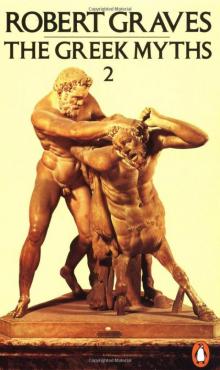 The Greek Myths, Volume2
The Greek Myths, Volume2 The Anger of Achilles: Homer's Iliad
The Anger of Achilles: Homer's Iliad Count Belisarius
Count Belisarius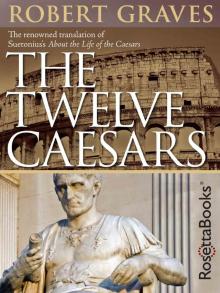 The Twelve Caesars
The Twelve Caesars Complete Poems 3 (Robert Graves Programme)
Complete Poems 3 (Robert Graves Programme) Homer's Daughter
Homer's Daughter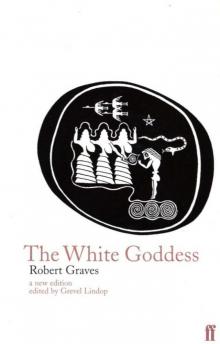 The White Goddess
The White Goddess Goodbye to All That
Goodbye to All That Claudius the God and His Wife Messalina
Claudius the God and His Wife Messalina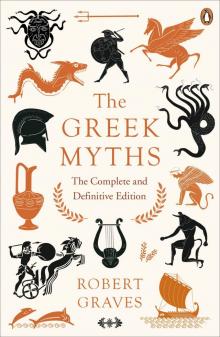 The Greek Myths
The Greek Myths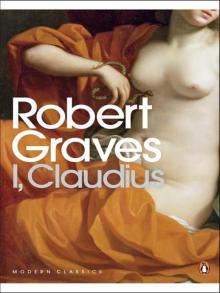 I, Claudius
I, Claudius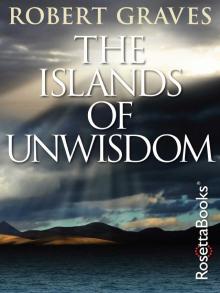 The Islands of Unwisdom
The Islands of Unwisdom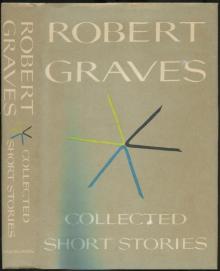 Complete Short Stories
Complete Short Stories The Golden Fleece
The Golden Fleece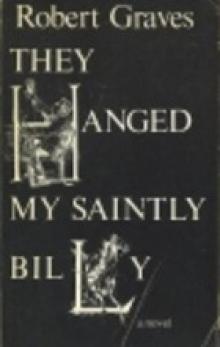 They Hanged My Saintly Billy
They Hanged My Saintly Billy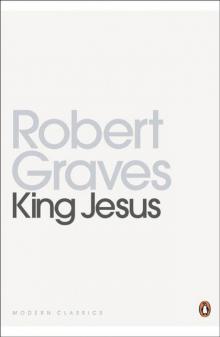 King Jesus
King Jesus Sergeant Lamb's America
Sergeant Lamb's America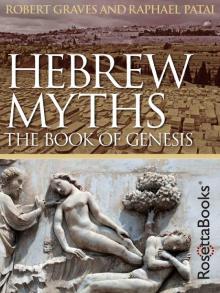 Hebrew Myths: The Book of Genesis
Hebrew Myths: The Book of Genesis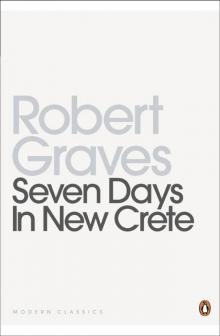 Seven Days in New Crete
Seven Days in New Crete Proceed, Sergeant Lamb
Proceed, Sergeant Lamb Claudius the God
Claudius the God Wife to Mr. Milton
Wife to Mr. Milton The Complete Poems
The Complete Poems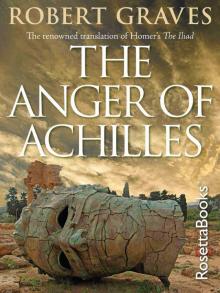 The Anger of Achilles
The Anger of Achilles Claudius the God c-2
Claudius the God c-2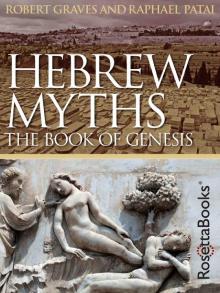 Hebrew Myths
Hebrew Myths I, Claudius c-1
I, Claudius c-1 The Greek Myths, Volume 1
The Greek Myths, Volume 1